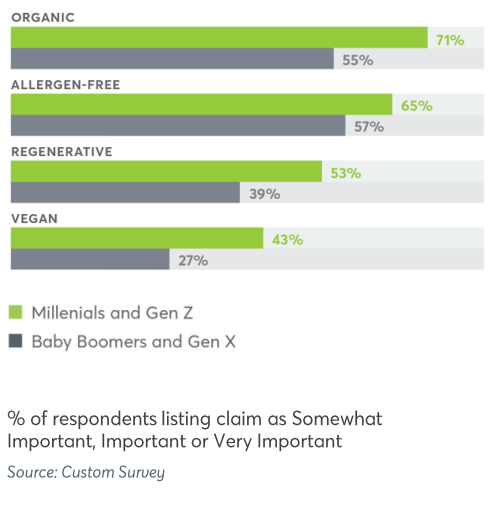
In recent years, the beginnings of a seismic shift have been observed in consumer behavior, primarily driven by the younger generations. Millennials and Gen Z are not just interested in what they eat; they are deeply invested in the values that their food represents. This trend towards value-based eating has the potential to transform the food industry, with organic food at the forefront of this revolution.
 The Organic Trade Association (OTA)’s 2024 Organic Industry Survey shows a consistent and growing interest in organic from Millennials and Gen Z. The latter generation grew up with organic and sustainability, and the health of people and planet, are all top-of-mind for these younger generations. Industry experts see this as an opportunity for increasing organic demand, with the industry well-positioned to meet the product attributes and values sought by consumers today and for future generations. OTA’s Consumer Perception of USDA Organic and Competing Label Claims Report reports that on average, organic, regenerative, vegan and allergen-free claims are 36% more important to Millennials and Gen Z than Gen X and Baby Boomer consumers.
The Organic Trade Association (OTA)’s 2024 Organic Industry Survey shows a consistent and growing interest in organic from Millennials and Gen Z. The latter generation grew up with organic and sustainability, and the health of people and planet, are all top-of-mind for these younger generations. Industry experts see this as an opportunity for increasing organic demand, with the industry well-positioned to meet the product attributes and values sought by consumers today and for future generations. OTA’s Consumer Perception of USDA Organic and Competing Label Claims Report reports that on average, organic, regenerative, vegan and allergen-free claims are 36% more important to Millennials and Gen Z than Gen X and Baby Boomer consumers.
Sustainability: A Core Concern
For younger consumers, sustainability is not a buzzword; it's an ethical choice inherent to how they see their ability to create change in the world. They are acutely aware of the environmental impact of their food choices and are actively seeking products that minimize harm to the planet. Organic farming practices, which typically avoid synthetic pesticides and fertilizers, are seen as a sustainable alternative. These practices promote soil health, reduce pollution, conserve water, and lower risk of pesticide exposure for the people who grow our food. By choosing organic, young consumers are casting their vote for a food system that prioritizes the long-term health of the planet and people.
 Animal Welfare: An Ethical Imperative
Animal Welfare: An Ethical Imperative
Animal welfare is another crucial factor driving the demand for organic products. OTA’s Consumer Perception of USDA Organic and Competing Label Claims Report shows that 50% of consumers agree with organic marketing claims indicating that organic products protect animal health and welfare. The younger generations are increasingly concerned about the ethical treatment of animals. Organic livestock farming, governed by stringent regulations, ensures animals are raised in conditions allowing them to express natural behaviors, are fed organic feed, and are not subjected to unnecessary antibiotics or hormones. Updates to the organic standards that strengthen animal welfare requirements such as the Organic Livestock and Poultry Standards (OLPS) provide assurance to these consumers that their food choices align with their ethical values.
Transparency: A Demand for Honesty
Transparency in food production processes has become a significant concern for young consumers. They want to know where their food comes from, how it is produced, and what it contains. The conventional food industry’s opacity is losing ground to the organic sector’s commitment to transparency.
The U.S. Department of Agriculture (USDA)’s National Organic Program (NOP) has developed an Organic Consumer Outreach Toolkit to promote transparency through the Four Pillars of USDA Organic:
- Protected by Law: The USDA organic label is the sole government-backed marketing claim for organic food sold in the United States. Only products that meet USDA organic standards can bear the organic seal.
- Inspected by Experts: Trained organic inspectors conduct annual visits to each organic farm and business to ensure compliance with organic standards. Surprise inspections and testing are also conducted regularly.
- Traced from Farm to Store: The Strengthening Organic Enforcement (SOE) rule enhances the USDA's ability to oversee and enforce organic standards, ensuring traceability of organic products from farm to store.
- Shaped by Public Input: Stakeholders and the public have the opportunity to provide feedback through public comments on proposed regulations, influencing final policy decisions.
Organic certification requires rigorous adherence to standards that are clearly communicated to consumers. This openness builds trust and allows consumers to make informed choices about the food they consume.
Health Consciousness: A Key Driver
Health is an overarching concern tying s together the values of sustainability, animal welfare, and transparency. Young consumers are increasingly aware of the health implications of their dietary choices. Organic foods, which are free from synthetic additives, preservatives, and genetically modified organisms (GMOs), are perceived as healthier alternatives. This perception is backed by studies suggesting that organic produce may contain higher levels of certain nutrients and lower levels of pesticide residues.
“There is a growing awareness among consumers about the potential health benefits associated with organic foods. Consumers desire cleaner, more nutritious food options. Many consumers, especially Gen Z, are more conscious of the ethical implications of their food choices and are looking for products that align with their values, such as animal welfare, fair trade, and support for organic farmers,” says Paul Schiefer, president of Amy’s Kitchen.
The Market Response
The market is responding to this shift with a proliferation of organic products. Supermarkets are expanding their organic sections, farmers' markets are more popular than ever, and new brands are emerging to meet the demand. The organic food market, once a niche segment, has grown at unprecedented rates, reflecting the priorities of younger consumers.
OTA’s 2024 Organic Industry Survey states that in 2023, the overall organic marketplace hit record dollar sales of $69.7 billion on 3.4% growth. Key trends helping to elevate organic growth include a growing consumer focus on personal and family health, sustainability, and a desire for clean products—those free from antibiotics, hormones, preservatives, dyes, allergens, and other artificial ingredients. These are pinnacles of Millennial and Gen Z buying trends.
New research completed by the Organic Trade Association in partnership with Euromonitor International shows that Gen Z, the age group that was born between 1997–2012 (ages 12 to 27), is playing a major role in the current demographic shift that is ushering in new consumer wants and needs and helping to drive some of these trends. This generation grew up with organic and its halo of being healthier for people and planet. By 2030, the U.S. population will consist of a majority driven by Millennials, Gen Z, and younger generations.
 Challenges and the Path Forward
Challenges and the Path Forward
However, the organic movement is not without its challenges. Higher costs of organic production often translate to higher prices, which can be a barrier for some consumers. Additionally, there is the challenge of ensuring the integrity of organic labels amidst rising demand. As the market grows, so does the need for stringent oversight and consumer education to maintain trust in organic certification. Still, OTA’s Organic Industry Survey illustrates that in 2023, the core organic consumers showed they valued organic and were willing to accept price increases and keep buying organic.
Trust in the USDA organic certification will continue to play a role in the marketplace’s growth. In 2023, the Strengthening Organic Enforcement (SOE) rule went into effect. This initiative is widely supported by the industry and will provide much-needed transparency across the USDA certified organic supply chain along with actionable ramifications to mitigate the potential for fraud in the organic marketplace. No other eco-certification is government regulated and so, no other certification has consequences, such as civil fines and jail time, when bad actors try to exploit the system.
Moving forward, the food industry must continue to innovate and adapt to meet the evolving values of younger consumers. This means not only expanding organic options but also making them accessible and affordable. It also involves fostering greater transparency and continuing to prioritize sustainability and animal welfare.
Continuing to meet the needs of these younger, up-and-coming generations will be critical to continuing to elevate organic in the marketplace, says Matthew Dillon, co-CEO at the Organic Trade Association. “We need to continue to delight and attract new customers. In order to do that, we have to realize the consumer is always evolving in their interests. Yesterday the focus was what was good for their kids, tomorrow it’s what’s good for the planet, and a week from now it will be what’s good for farmers. Interests and values are always evolving and in organic, we have to be able to capture these evolving interests.”
Conclusion
Younger generations are driving a transformation in the food industry, guided by a holistic set of values encompassing sustainability, animal welfare, transparency, and health. The rise of organic food is a testament to their influence. As they continue to advocate for a food system that aligns with their values, the industry must rise to the challenge, ensuring that the principles of value-based eating are upheld and advanced. This shift is not just a trend; it is the future of food.
References:
- 2024 Organic Industry Survey
- Consumer Perception of USDA Organic and Competing Label Claims Report
- USDA Organic Retailer Toolkit

